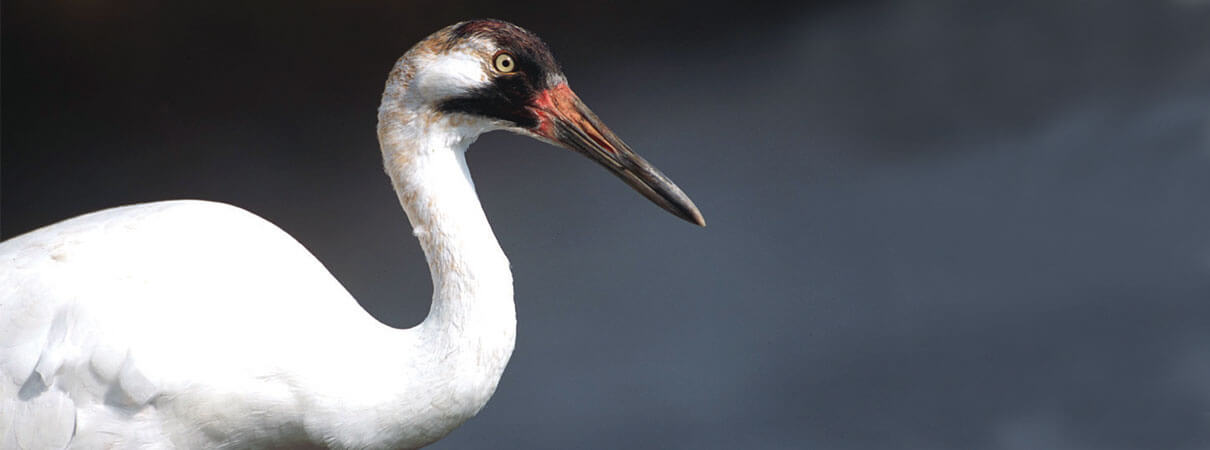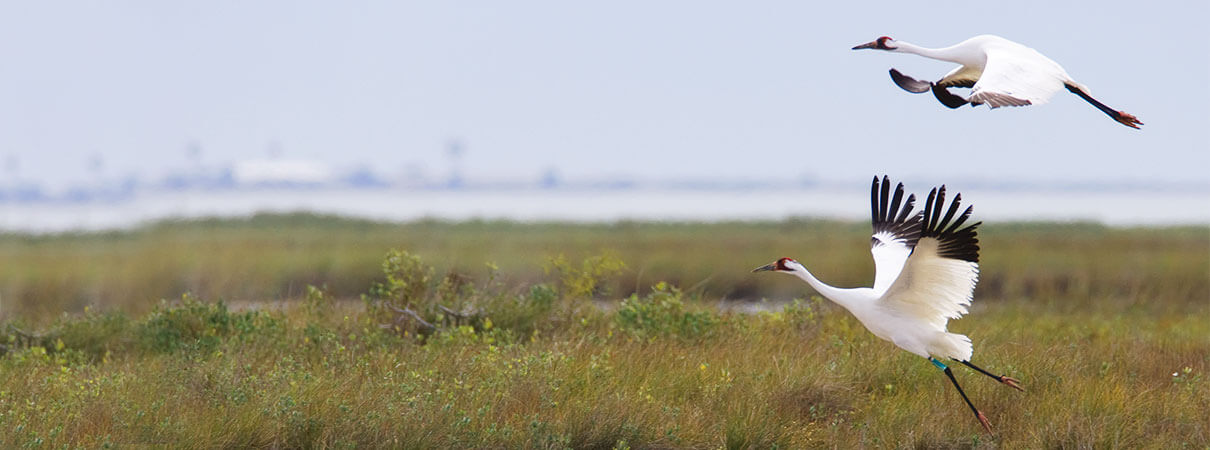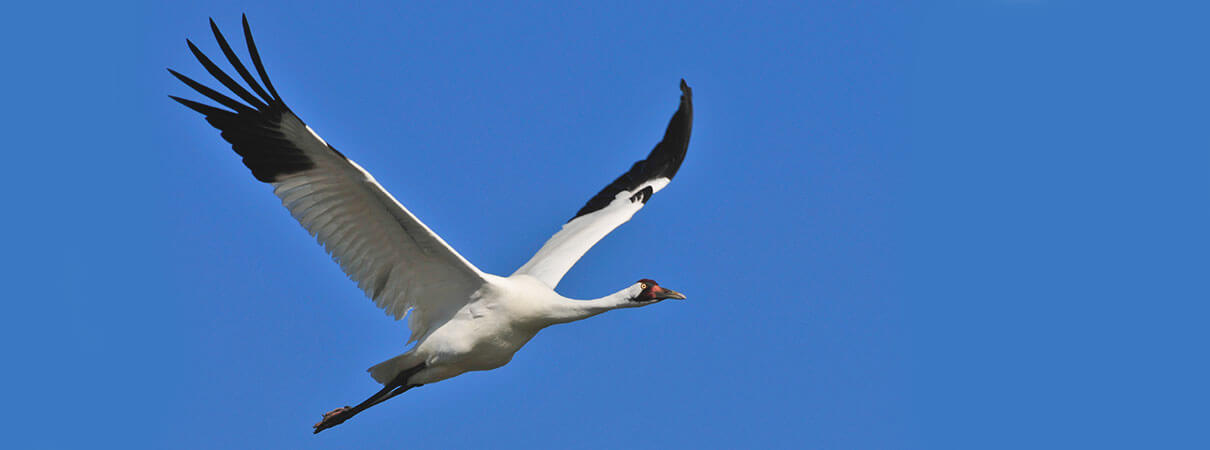A High-wire Act to Protect Whooping Cranes from Powerlines
Kansas power companies join forces to prevent crane-powerline collisions
The Whooping Crane is a bird of distinction. North America's tallest bird and one of its most endangered species, this gleaming-white, 15-pound wetland denizen almost became as mythical as the now-extinct Passenger Pigeon. In the early 1940s, only 15 remained.
Thanks to years of hard-fought conservation gains, the one remaining self-sustaining migratory Whooping Crane flock now numbers more than 500 individuals. Every year, they fly from breeding grounds in Canada's remote Wood Buffalo National Park to winter on the Texas coast, before heading back north again.
This annual journey of 2,500 miles each way takes the birds through the heartland of North America. There, they rely on wetlands in the Great Plains to rest and refuel. Over the years, two key areas in Kansas — Quivira National Wildlife Refuge and a collection of preserves known as Cheyenne Bottoms — have provided safe haven for Whooping Cranes passing through the state.

Whooping Crane. Photo by USFWS
Migration can be an especially vulnerable time, as travel-weary birds set down in relatively unfamiliar places. In the past, hunters were a major problem. Occasionally, a protected crane is still shot by accident or intentionally, but these days, a far more pervasive danger looms large over the flat landscapes these birds navigate: powerlines.
The Peril of Powerlines
Especially in the poor visibility of dawn, dusk, or fog, birds frequently collide with them. Each year in the United States, as many as 25 million birds die after colliding with powerlines. And a 2008 report by researchers from the U.S. Fish and Wildlife Service (USFWS) and Texas State University found that powerline collisions are the number-one known cause of mortality for recently fledged migratory Whooping Cranes.
Fortunately, since the 1980s, a group of forward-looking power company representatives called the Avian Power Line Interaction Committee (APLIC) has been developing methods to reduce both collisions and electrocutions of birds. The challenge is to try to keep run-ins between cranes and lines to an absolute minimum.
Kansas utilities are now working with conservationists to ensure a brighter future for Whooping Cranes and other birds. Nearing completion, their efforts to make powerlines more crane-friendly provide a heartening example of how the private, public, and nonprofit sectors can come together to do good for birds.

Whooping Crane family. Photo by Richard Seeley/Shuterstock
Working to Safeguard Weary Whoopers
In 2010, the USFWS issued guidance for how power companies in the region should address the risk of Whooping Crane collisions with powerlines. Ideally, the guidance document advised, new lines constructed within the cranes' migratory corridor should be buried underground. In many cases, however, burying lines isn't feasible, so the USFWS also proposed an alternative: Utilities could opt to “mark” their lines, outfitting them with devices to make them more visible to birds in flight.
Many of Kansas' power companies are small co-ops. Eric Johnson of Westar Energy, one of the state's larger utilities, describes a typical outfit as “maybe one executive director and a crew of five linemen.” Lacking on-staff biologists and other resources, small companies would have had trouble implementing the new USFWS recommendations on their own.
The solution? Kansas' electrical utilities formed a flock. The first step was simply identifying which lines were the highest priority for marking — that is, which ones most likely hung in the path of travel-weary cranes.
“Most people look at a map of the lower 48 states and they see an arrow where a migration corridor is, and then they see powerlines cutting across that, and they get worried,” says Anne Lacy, a researcher with the Wisconsin-based International Crane Foundation. “But it's okay if a bird is flying 2 miles above that powerline — that's perfectly safe. But those stopover areas are really critical. The cranes are in an unknown place, they're tired because they've just flown several hundred miles, and they maybe aren't as aware of their surroundings. They're coming in low, it might be evening when there's low light, and that's where it's critical to either not have those powerlines at all, or if they are there, to have them marked.”
Power Companies and Birdwatchers Unite
Starting within a 5-mile radius around Quivira and Cheyenne Bottoms, the Kansas utilities worked with environmental consultants on an assessment that considered factors such as lines' proximity to crane roosting and feeding sites. The USFWS guidance instructed that when new lines were installed in sensitive areas, not only should new lines be marked — additional stretches of line elsewhere should be marked as well, with this additional step aimed at further offsetting the risks posed by new construction.
Small companies may not own additional lines in high-priority areas, however, so the utilities pooled their resources, each contributing money to a fund held by a nonprofit to be used by whomever did have high-priority lines to mark. An advisory group including representatives from nonprofits such as The Nature Conservancy and the Kansas Ornithological Society, government agencies, and power companies was formed to provide additional guidance for the project.
“It's been encouraging to see everybody come together for one very specific purpose,” says the Kansas Ornithological Society's Chuck Otte, who was an early recruit to the advisory group. “The representatives from the power companies, they're learning about how birds behave and about our concerns as birdwatchers. And as a birdwatcher, I've learned more about different kinds of insulators and powerlines than I ever thought possible. All of that stuff has been absolutely fascinating to me.”

Whooping Cranes. Photo by Al Perry
Making the Lines Easier to See
“There are a lot of different line-marking products out there on the market,” says Westar's Eric Johnson. “Some of them have had scientific studies done on how effective they are, others haven't, but when it comes down to it, anything that makes the line more noticeable or larger in diameter will do something for birds.
"Some of them are just a spiral of pre-formed plastic that wraps around the line and makes it more obvious, and then there are others that are a little more active," Johnson continues. "You can clip them on the line and they spin with the wind.”
Some of these devices can be installed from the ground, but on the largest cross-country lines the work needs to be done from above via helicopter. In these cases, a highly trained lineman sits outside the helicopter while it hovers alongside the line, then reaches out and clips on the device by hand.
Protecting More than Cranes
The work began in 2015. So far, 160 miles of the identified high-priority lines have been marked in and around the two protected areas. According to Johnson, all 113 miles of high-priority lines at Cheyenne Bottoms will be completed by the end of 2019, as well as 90 miles of the total of 130 at Quivira.
Otte acknowledges that it's impossible to completely eliminate the risk of Whooping Crane collisions with powerlines, but he says the work makes a difference. “These are things that aren't just going to protect Whooping Cranes, they're going to protect Sandhill Cranes, they're going to protect ducks and geese, they're going to help all sorts of birds. So that in and of itself is a success.
"I mean, we all want to have electricity," says Johnson, "but how can we provide electricity to the people of this country while minimizing the potential negative impact for the wildlife? To me, that's what this is all about.”
Co-existing Along Migration Routes
Decades of hard work have already been done to nurture and protect Whooping Cranes. The result has been one of the greatest bird comeback stories, and a shining example of two countries collaborating to save a species. Federal, state, and provincial agencies from both the United States and Canada, working with nonprofit groups as well as the private sector, continue to preserve and manage key habitat and closely monitor the cranes' nesting success. New technologies such as satellite tracking are enabling biologists to learn more than ever before about their behavior and annual migration. And now the Kansas line-marking project provides reasons to hope that cranes and people can coexist along the migration routes.
Anne Lacy says she's “cautiously optimistic” about Whooping Cranes' future. “We're living on this landscape and we are having an impact, period, full stop. Now, how do we lessen that impact on the things that are living there already? That's probably a lesson that all of us can learn.”
This story was originally published in the Winter 2018-2019 edition of ABC's Bird Conservation magazine. Sign up to become an ABC member today to receive a 12-month subscription to Bird Conservation.
 | Rebecca Heisman is an environmental educator turned-science writer and communicator. |



















































